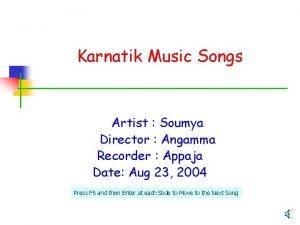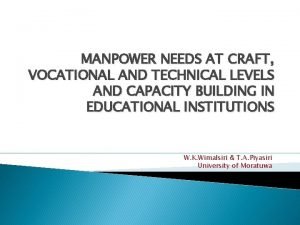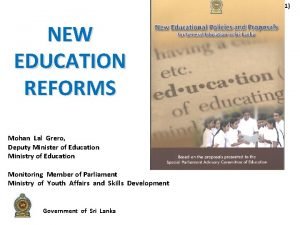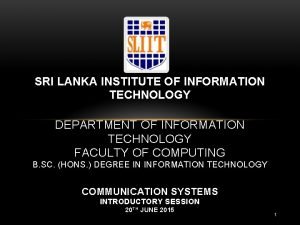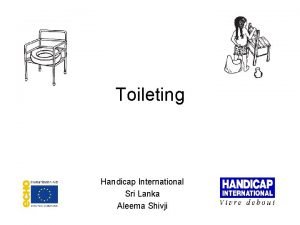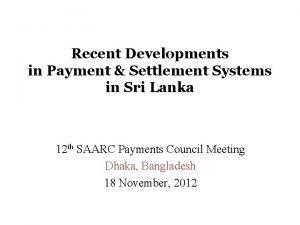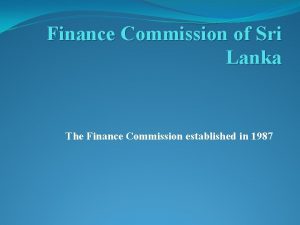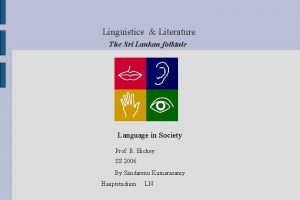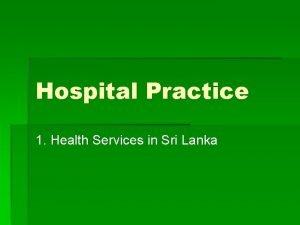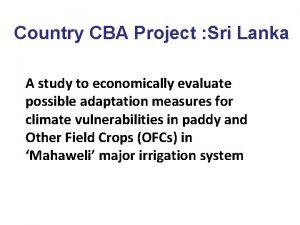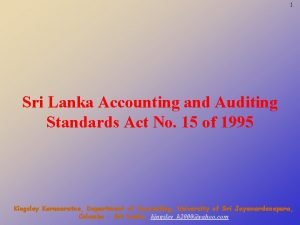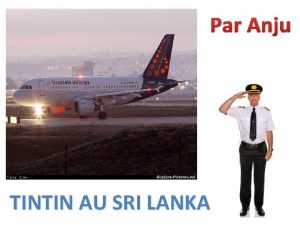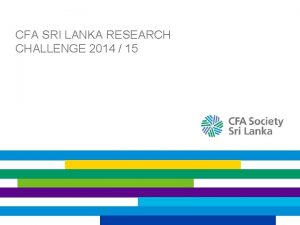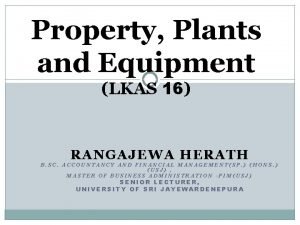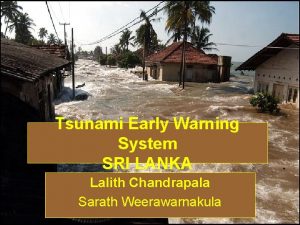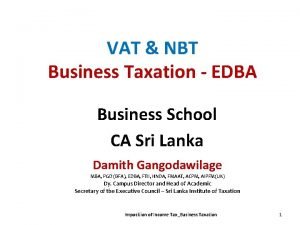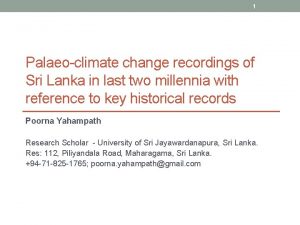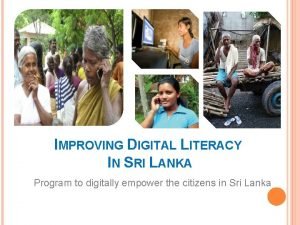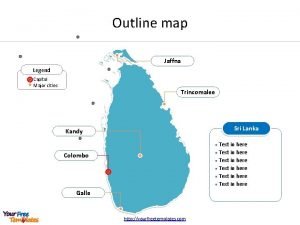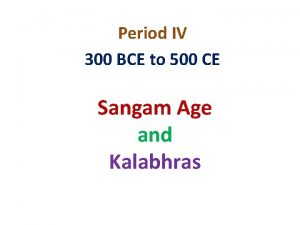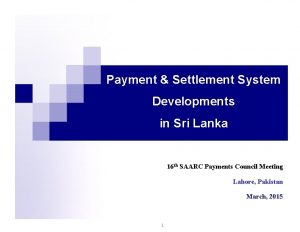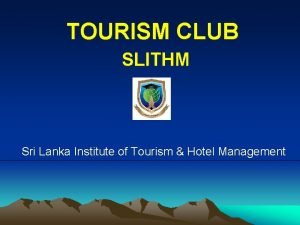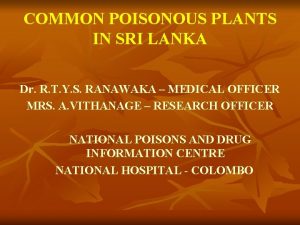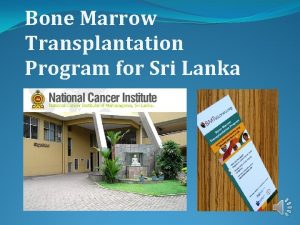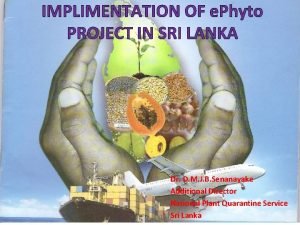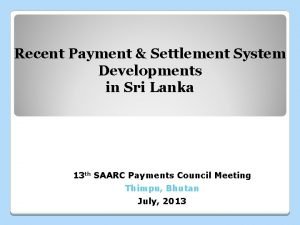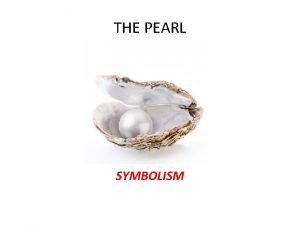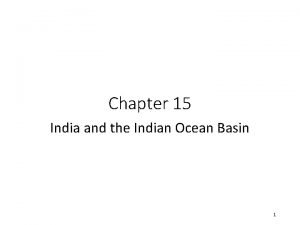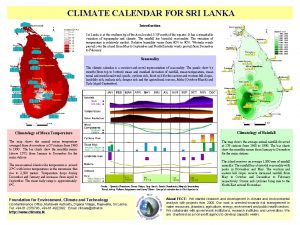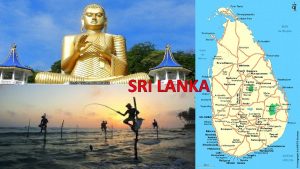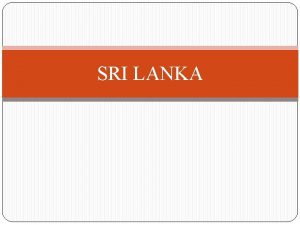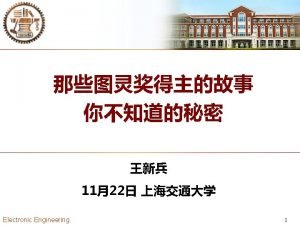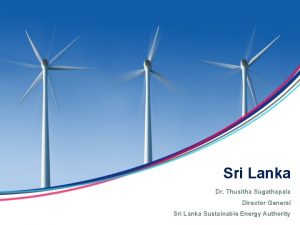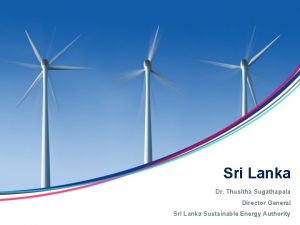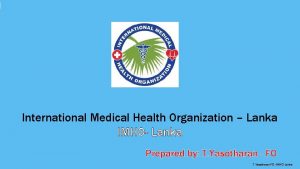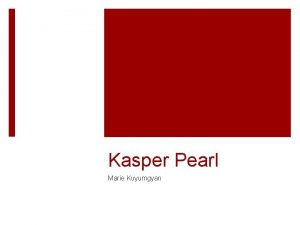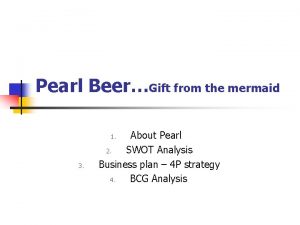Sri Lanka Pearl of the Indian Ocean A














































- Slides: 46

Sri Lanka Pearl of the Indian Ocean A Profile of Information Technology

Group Members • Ed Lavallee – Background • Amy Liang – IT & e. Commerce • Xio. Feng Zhang – Investment Opportunity

The Teardrop of India

The People & Ethnic Groups • • Population: 20, 222, 240 Ethnic groups: – • Religions: – • Buddhist 69. 1%, Muslim 7. 6%, Hindu 7. 1%, Christian 6. 2%, unspecified 10% Languages: – – • Sinhalese 73. 8%, Sri Lankan Moors 7. 2%, Indian Tamil 4. 6%, Sri Lankan Tamil 3. 9%, other 0. 5%, unspecified 10% Sinhala (official and national language) 74%, Tamil (national language) 18%, other 8% English is commonly used in government and is spoken competently by about 10% of the population Literacy: definition: age 15 and over can read and write – total population: 92. 3% • male: 94. 8% female: 90% (2003 est. ) Source: CIA – The World Factbook (https: //www. cia. gov/cia/publications/factbook/geos/ce. html)

Geography & Climate • Geography – Slightly Larger than West Virginia • 65, 610 square kilometers • 1, 340 kilometers of coastline – Mostly low, flat to rolling plains, mountains in south-central interior – Strategic location near major Indian Ocean sea lanes • Climate – Monsoon seasons - Dec-Mar & Jun-Oct – In late December 2004, a major tsunami took about 31, 000 lives, left more than 6, 300 missing and 443, 000 displaced, and destroyed an estimated $1. 5 billion worth of property Source: CIA – The World Factbook (https: //www. cia. gov/cia/publications/factbook/geos/ce. html)

Short History • Originally settled by Sinhalese from Northern India • 14 th Century, a south Indian dynasty established Tamil kingdom in the north • Occupied by Portuguese in the 16 th century and Dutch in the 17 th century • Island was ceded to the British in 1796 and remained a British colony until 1948 • Ceylon declared its independence in 1948 and became Sri Lanka in 1972 • Ethnic unrest erupted in 1983 between the Sinhalese majority and the Tamil separatists – Formal cease fire in 2002 – Recent terrorist attacks threaten stability of the country Source: CIA – The World Factbook (https: //www. cia. gov/cia/publications/factbook/geos/ce. html)

Government Democratic Socialist Republic of Sri Lanka • Government Type: Republic • Capital: Colombo • Three branches of government – Executive – President (6 year term) – Legislative – One Parliament (225 seats; 6 year term) – Judicial – Supreme Court, Court of Appeals (Judges are appointed by President) • 8 provinces: Central, North Eastern, North Western, Sabaragamuwa, Southern, Uva, Western Source: CIA – The World Factbook (https: //www. cia. gov/cia/publications/factbook/geos/ce. html)

Challenges • Civil Unrest – Tamil Tigers – 2002 cease-fire agreement between Liberation Tigers of Tamil Eelam (LTTE) and the Sri Lankan government has recently been violated by actions on both sides • Bomb blast on SLN vehicles, 70 killed (OCT 16 Link) • Rebels launch suicide attack on Sri Lanka naval base in south, 1 sailor killed (OCT 18 Link) • Tigers ready for talks, Colombo should end offensives, air-strikes Thamilchelvan (OCT 19 Link) – New peace talks scheduled at the end of October in Geneva

Economy • Currency: Sri Lankan Rupee ($1 US = 105. 85 LKR) • Gross Domestic Product: – GDP (purchasing power parity): $85. 34 billion (2005 est. ) – Per Capita GDP: $4, 300 (2005 est. ) – GDP Composition by sector: • agriculture: 17. 8% industry: 27. 6% services: 54. 5% (2005 est. ) • Public Debt: 92. 8% of GDP – External debt: $11. 05 billion – Economic Aid: $577 million • Gini index: 34. 4 (1995) Source: CIA – The World Factbook (https: //www. cia. gov/cia/publications/factbook/geos/ce. html)

Economy • Industries – Processing of rubber, tea, coconuts, tobacco and other agricultural commodities; telecommunications, insurance, banking; clothing, textiles; cement, petroleum refining • Exports – Products: textiles and apparel, tea and spices; gemstones; coconut products, rubber manufactures, fish – US 30. 9%, UK 11. 6%, India 7. 3%, Belgium 4. 8%, Germany 4. 5% (2005) • Labor force: 8. 08 million – Occupational Breakdown: • agriculture: 38% industry: 17% services: 45% (1998 est. ) • Unemployment: 7. 7% (2005 est. ) Source: CIA – The World Factbook (https: //www. cia. gov/cia/publications/factbook/geos/ce. html)

Hofstede’s Cultural Dimensions Low Power Distance High USA 40 Low India Sri Lanka 77 80 Individualism vs. Collectivism Nepal Sri Lanka 30 35 Low Nepal 65 High India 48 USA 91 Uncertainty Avoidance High Nepal India Sri Lanka USA 40 40 45 46 Low Masculinity vs. Femininity (Femininity) Sri Lanka 10 Nepal 40 India 56 USA 62 High (Masculinity) **Low score in this dimension is likely due to the predominant religion – Buddhism, which is very group and relationship focused. Low Long term orientation USA 29 High Sri Lanka 45 India 61 Source: http: //www. u. arizona. edu/~nichalin/myfiles/South. Asia-Final. ppt

IT – Telephones & Broadcast • Telephones – Main lines in use: 1, 130, 923 – Mobile Cellular: 3, 084, 845 – Inadequate domestic service, particularly in the rural areas. • Likely to improve with privatization & encouragement of private investment • Broadcast stations – Radio: AM 26, FM 45; Shortwave 1 – Television: 21 Source: CIA – The World Factbook (https: //www. cia. gov/cia/publications/factbook/geos/ce. html)

IT-Computer Literacy • • Government sponsored survey of household members in the age group of 5 – 69 years of scientifically selected 11, 500 households Definition of literacy was being able to “do something” with the computer Most literate were located in urban areas Overall. 7% of households in nation have internet capability, however 20% of households with computers have internet access No 1 Indicator % 9. 7 2 Computer literacy (Percentage of population in the age group of 5 – 69 who can use computers) Households having computers (National) 3 Households having computers (Urban sector) 10. 5 4 Households having computers (Rural sector) 3. 1 5 Households having computers (Estate sector) 0. 3 6 Households having e-mail facility 0. 9 7 Households having internet facility 0. 7 8 Households having computers which had been bought within the 24 months prior to the survey Households having computers and using them for less than 10 hours per week 44. 2 Households having computers and experiencing faults during the three months prior to the survey Households without computers and strongly feeling the need to have one 26. 6 Household population in the age group of 5 – 69 years, who are aware about computers and their applications Household population in the age group of 5 – 69 years who can use e-mail on their own 18. 2 Household population in the age group of 5 – 69 years who can use internet on their own 2. 6 9 10 11 12 13 14 Source: Computer Literacy of Sri Lanka; Department of Census & Statistics – Sri Lanka; http: //www. statistics. gov. lk/cls 2004/index. htm 3. 8 53. 3 36. 1 2. 8

Geographic Map of Computer Literacy Source: Computer Literacy of Sri Lanka; Department of Census & Statistics – Sri Lanka; http: //www. statistics. gov. lk/cls 2004/index. htm

e-Sri Lanka Initiative • Purpose is to use Information and Communication Technologies (ICT) to develop the economy, reduce poverty and improve the quality of life of the people. – ICT Agency’s core mandate: • Create a national ICT Plan • Encourage mainstream adoption of ICT in public and private sectors – The Agency’s program areas are given below: • • • Build the implementation capacity Build an information infrastructure and an enabling environment, Developing ICT human resources Modernizing government and delivering citizen services Leveraging ICT for economic and social development, through publicprivate partnerships Source: Information and Communication Technology Agency of Sri Lanka (ICTA); http: //www. icta. lk/insidepages/e-srilanka. asp

Infrastructure • Today, Sri Lanka's infrastructure ranks as the best available in South Asia. – Private and public investment programs have been implemented to improve the country's basic infrastructure facilities. • Currently there are private investment projects in power, ports, water sanitation, transportation (highways and rail) and IT. • Telecommunications – Operations by multiple public and private telephone service providers, including three basic, four cellular and six payphone services, making the industry one of the most competitive in Asia. – Deregulation has resulted in the country's largest ever privatization initiative, with NTT of Japan purchasing 35% of Sri Lanka Telecom for US$ 225 million. • Roads – The construction of 4 major expressways will improve the existing road network. Source: Board of Investment of Sri Lanka; http: //www. boi. lk/BOI 2005/content. asp? content=whyinvest 8&Sub. Menu. ID=8

E-Commerce Implementation • Survey by Sri Lanka Business Development Center • 80 Small and Medium Enterprises (SMEs) Source: http: //www. asiafoundation. org/pdf/SMEsurvey_srilanka. pdf

E-Commerce Implementation • Internet Usage

E-Commerce Implementation

E-Commerce Implementation * 100% uses internet for trade research.

E-Commerce Implementation • Web Sites Maintenance – Driving forces for establish web sites: “global exposure” and “direct interface with the customers” – Primary purpose of the site is to “promote sales” – Majority of the SMEs agree that the Web sites are important to improve business exposure. – The web hosting companies developed most of the sites while in-house development came second.

E-Commerce Implementation Web Sites Location and Development Cost Rs. : USD = 100: 1

E-Commerce Implementation • E-Commerce Penetration – Web based selling is not well established in Sri Lanka. – Sales volumes were at the low end for the few who used web based selling. – Everybody is positive about the sales to increase in the coming months. – The portals do not provide enough sales information at present. – Web based buying is limited to a few types of items. – No local establishments have B 2 B transactions. – Buying frequency varied. 37% declared they buy very rarely. – Purchase volumes over the Internet are very low. – Bottleneck to purchase goods over the Internet – Payment method. – Using web portals for business propagation is not widespread among SMEs.

E-Commerce Implementation • Banking Sector Applications • The main reason for non-usage is the security concern. • I-banking may sure catch up similar to the ATM cards since most of the banking operations except cash could be carried out from home.

E-Commerce Implementation • Non Internet or E-Commerce Users – Worries about the cost – Lack of staff with adequate knowledge to run an internet based application – Infrastructural facilities (such as insufficient telephone connections) – The management’s perceived lack of knowledge on the benefits of ecommerce Prospective Users

Investment Opportunities and Challenges Investing in manufacturing semiconductor in Sri Lanka • How it works? Private investor in the U. S. establishes joint venture with Sri Lanka government or local private businesses U. S. investor contributing technology and more than 50% of the capital Use local labor force for manufacturing and local management Set up production shops on the southwest coast, close to Colombo or Galle Ship in raw materials from Asia, and ship out the finished products back to Asia market (China, India, Japan etc)

Why semiconductor? Semiconductor A solid whose electrical conductivity can be controlled over a wide range, either permanently or dynamically Essential materials in all modern electrical devices, from computers to cellular phones to digital audio players Source: http: //en. wikipedia. org/wiki/Semiconductor

Why semiconductor?

Why semiconductor?

Why manufacturing in Sri Lanka? • Cheap Labor Population (1) – The latest destination for British companies outsourcing their operations overseas. Sourace: http: //news. bbc. co. uk/1/hi/business/3891023. stm – Labor costs are lower in Sri Lanka than India: Costs in Sri Lanka are 20% to 40% lower than in India (- Virtusa, a provider of IT and BPO services. ) Source: http: //knowledge. wharton. upenn. edu/100902_ss 5. htm – “Sri Lanka has the lowest labor cost per worker in manufacturing” (World Bank Development Indicators 2000) http: //www. boi. lk/Investor. Site/content. asp? content=whyinvest 4&Sub. Menu. ID=4

Why manufacturing in Sri Lanka? Labor cost: monthly (US$) Source: http: //www. boi. lk

Why manufacturing in Sri Lanka? • 92% high literacy (2) – Easy to train and manage • Good health (life longevity longer than India) (3) – Ideal for physical and assembly line work • Educated, English-speaking professionals (4) – Local university educated, English-speaking professionals – can be used as local managers to build the bridge with local community – managing the local facilities and dealing with gov’t and local businesses.

Why manufacturing in Sri Lanka? • Favorable governmental policies (5) – Constitutional Guarantee for Foreign Investments • Bilateral investment agreements are valid for 10 years • extended automatically unless terminated by either party • If the agreement is terminated, investments already made are protected for another 10 year • Free remittance of earnings, capital and business fees • Settlement of disputes under the International Convention for the Settlement of Investment Disputes (ICSID)” Source: Board of Investment of Sri Lanka

Why manufacturing in Sri Lanka? • Strategic location (6) Regional trading hub and short shipping distance to 4 continents - 16 airports and 2 seaports Colombo Port • No. 01 port of South Asia and the 26 th in the World • Transshipment cargo accounts for 72% of throughput • Computerized and linked to all major freight stations • Fast turnaround and round the clock service • EDI facilities with two modern container terminals Source: Board of Investment of Sri Lanka

Why manufacturing in Sri Lanka? Bandaranaike International Airport (BIA) • # 1 regional hub of air transportation in South Asia • Frequent flights to Europe, Middle East, Far East, Australia, and the Indian Sub Continent • Passenger movement increased from 2, 234, 962 in 1995 to 2, 880, 387 in 2000, a 29% increase • The cargo movements at BIA has increased from 76, 312 tons in 1995 to 127, 116 tons in 2000 respectively, a marked 76% increase • The aircraft movement in the same period has increased from 16, 543 to 21, 058, a 27% increase Source: Board of Investment of Sri Lanka

Why manufacturing in Sri Lanka? • Indo – Lanka FTA (7) Easy to expand into Indian market in the future if needed – With its 1 billion population, India is a big market. Should the investor(s) contemplates – Moving into that market to establish production facilities or just to sell, FTA between the two nations would serve a favorable channel for the both options.

Why manufacturing in Sri Lanka? • Ease of doing business (Total 175) (8) Source: World Bank 2006 study

Why manufacturing in Sri Lanka? • Peace through development (9) • Civil conflict is an economical issue • Fight for interest. Once interest met, peace becomes possible • Development Opportunities Peace • Canada model, still fight?

Why manufacturing in Sri Lanka? • “The worst waste in business is not money, but opportunity” – anonymous (10) Sri Lanka – a virgin territory for investment Opportunity lies under risk - Tamil not averse to foreigners - Produce in the peaceful region (west coast)

Why manufacturing in Sri Lanka? • Quality life for expatriates (11) • Beautiful beaches and resort foreigners • Exotic tropical fruits • Industry park • International Schools

Why manufacturing in Sri Lanka? http: //www. srilanka. com/photogallery/gallery. php

Why manufacturing in Sri Lanka? http: //images. google. com

Why manufacturing in Sri Lanka? http: //www. srilanka. com/photogallery/gallery. php

Why manufacturing in Sri Lanka? http: //images. google. com

Why manufacturing in Sri Lanka? http: //www. srilanka. com/photogallery/gallery. php

Some Sri Lanka Websites • • Board of Investment – Sri Lanka GOSL (Government of Sri Lanka) Lanka. Newspapers. com – Sri Lanka news e. Sri. Lanka – in English; in Sinhala; in Tamil
 Sri rama sri rama sri manoharama
Sri rama sri rama sri manoharama Nvq levels in sri lanka
Nvq levels in sri lanka Www.mohanscience.lk
Www.mohanscience.lk Methyl bromide fumigation certificate
Methyl bromide fumigation certificate Corporate governance in sri lanka
Corporate governance in sri lanka Agriculture insurance in sri lanka
Agriculture insurance in sri lanka Food and beverage industry in sri lanka
Food and beverage industry in sri lanka Courseweb.sliit.lk
Courseweb.sliit.lk Climate data sri lanka
Climate data sri lanka Sri lanka tea board elevation average
Sri lanka tea board elevation average Handicap international sri lanka
Handicap international sri lanka Payment and settlement system in sri lanka
Payment and settlement system in sri lanka Finance commission of sri lanka
Finance commission of sri lanka Sri lanka folk tales
Sri lanka folk tales Administrative structure of health service in sri lanka
Administrative structure of health service in sri lanka Cba sri lanka
Cba sri lanka Semi condominium
Semi condominium Seismometer in sri lanka
Seismometer in sri lanka Sri lanka auditing standards
Sri lanka auditing standards Kirribath
Kirribath Cfa sri lanka
Cfa sri lanka Shotokan karate sri lanka
Shotokan karate sri lanka Lkas
Lkas Tsunami early warning system sri lanka
Tsunami early warning system sri lanka Labai. lk
Labai. lk Metric map sri lanka
Metric map sri lanka Presentation supply
Presentation supply Collab sri lanka
Collab sri lanka Northeast monsoon sri lanka
Northeast monsoon sri lanka Compare india and sri lanka on the basis of hdi
Compare india and sri lanka on the basis of hdi Digital literacy in sri lanka 2021
Digital literacy in sri lanka 2021 English note grade 11
English note grade 11 Map sri lanka capital
Map sri lanka capital Chera kingdom map
Chera kingdom map Payment and settlement system in sri lanka
Payment and settlement system in sri lanka Sri lanka institute of information technology affiliations
Sri lanka institute of information technology affiliations Disaster management centre sri lanka
Disaster management centre sri lanka Wel kaduru tree
Wel kaduru tree Tiep 1 application form
Tiep 1 application form Nigel barker sri lanka
Nigel barker sri lanka Writ jurisdiction in sri lanka
Writ jurisdiction in sri lanka Bone marrow transplantation sri lanka
Bone marrow transplantation sri lanka Sri lankan vegetables
Sri lankan vegetables Payment and settlement system in sri lanka
Payment and settlement system in sri lanka Ravana generation
Ravana generation What does a pearl symbolize
What does a pearl symbolize Indian ocean basins
Indian ocean basins
